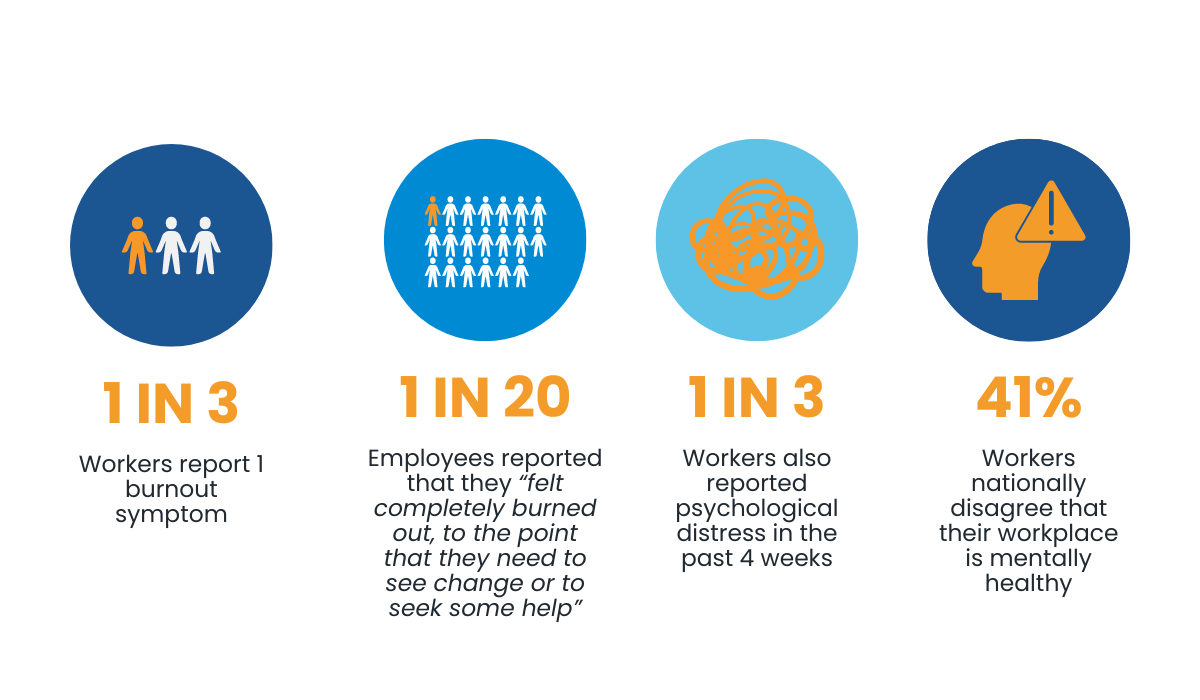In recent years, the focus on workplace wellbeing has intensified, with companies worldwide investing in initiatives to promote a healthier workforce. However, a concerning trend has emerged which can cause more harm than good – wellbeing washing.
What is wellbeing washing?
Much like the concept of greenwashing in environmental sustainability, wellbeing washing occurs when organisations prioritise the appearance of caring about employee wellbeing over implementing meaningful strategies to support it. Despite well intentioned efforts, many companies fall into the trap of superficially addressing mental health concerns without tackling the root causes.
Common examples of wellbeing washing
- Hosting talks on stress and workplace fatigue without implementing actionable strategies
- Offering wellness perks, such as yoga classes and other social events, while employees face unsustainable workloads or exposure to significant psychosocial hazards
- Participating in mental health awareness campaigns yet failing to create long-term commitments to internally support it
- Implementing “wellbeing” initiatives that are focused entirely on increasing productivity and don’t consider lived experience*
- Focusing on the individual's role in their wellbeing instead of looking at the organisations behaviour and policies to keep people psychologically safe
The Impact of Wellbeing Washing
The consequences of wellbeing washing extend beyond mere perception. Employees may be left feeling unsupported, undervalued and cynical and are more likely to experience disengagement and higher turnover rates. This can be seen through SuperFriend’s Indicators of Thriving Workplace report, where of those reporting that their organisation has mental health and wellbeing policies in place, more than 1 in 3 (36%) disagreed that their workplace was mentally healthy; the discrepancy between organisations reporting their perception and intention versus how it is being perceived by employees can be a sign of wellbeing washing. It shows that the initiatives being implemented are possibly not strategically aligned to the needs of the workplace and are just about the optics.
This not only damages morale but also undermines organisational credibility, as employees recognise when their wellbeing is merely a ‘checkbox’ on the company's agenda or governance.
Understanding the Wellbeing Discrepancy: Perception vs. Reality
A global study by McKinsey Health Institute (2022) revealed a significant gap between employer and employee perceptions of workplace wellbeing. While leaders often rated all aspects of wellbeing favourably, employees painted a different picture, citing toxic workplace behaviours as the primary driver of burnout symptoms.
Burnout is a significant issue, demonstrated by the national workforce Indicators of a Thriving Workplace 2023 data which showed that:- Almost one in three workers report at least one symptom of burnout
- One in 20 reported that they “felt completely burned out, to the point that they need to see change or to seek some help”
- Over 1 in 3 workers also reported psychological distress in the past 4 weeks (symptoms consistent with a moderate – severe mental health condition)
- Correspondingly, 41% of workers nationally disagree that their workplace is mentally healthy

Dr. Michelle McQuaid, Founder of the Wellbeing Lab suggests that while some instances of wellbeing washing may be unintentional, they stem from a fundamental misunderstanding of what true wellbeing entails. To bridge this gap, organisations must prioritise open communication and actively seek feedback from employees regarding their wellbeing needs and preferences.
Where does psychosocial hazard management fit?
The recent changes to psychosocial risk legislation has meant that organisations need to focus on a number of factors that commonly cause injury, and requires workplaces to look internally to their organisational culture, policies, processes and people capabilities to ensure they are doing everything reasonably possible to mitigate harm from occurring. Workplaces putting in place meaningful, evidence informed controls and taking an integrated approach are far more likely to have a positive impact on workers mental health than implementing initiatives that are piecemeal and not based on evidence.
SuperFriend's Five Domains
SuperFriend conducts the biggest workplace mental health and wellbeing survey in the country each year, and through this we have gained a large amount of insights on what works, and what pays lip service to worker wellbeing. Through this knowledge and expertise we have categorised what we see into five domains. Taking an integrated approach to workplace wellbeing and implementing initiatives that address concerns under all of these areas, will minimise the likelihood of wellbeing washing occurring. The five domains are:
- Connectedness – the quality of the interpersonal relationships
- Leadership – how managers support their workers mental health
- Safety – protection from harmful experiences such as harassment, bullying, discrimination and violence
- Capability – skills and resources available to support mental health
- Work Design – how roles, tasks and responsibilities are organised
![]()
Promoting a Culture of ‘Authentic Wellbeing’
Wellbeing is not solely the responsibility of Health and Safety leaders; it requires collective effort and commitment from all levels of the organisation. Leaders must lead by example, actively participating in wellbeing initiatives to create a culture of transparency and support.
The flipside of wellbeing washing is Leadership that clearly demonstrates the importance of employee health and wellbeing, advocates for the best interests of their team and demonstrates with actions, i.e. leaders showing they support their own mental health. These are key indicators of the Indicators of a Thriving Workplace Leadership domain. Our 2023 data showed that higher mean Leadership scores were predictive of higher intentions to stay, lower levels of burnout and lower psychological distress.
Navigating Wellbeing: A Four-Stage Approach
- Measure: Thoroughly assess employee needs and experiences.
- Understand: Analyse data to identify discrepancies.
- Act: Implement targeted interventions based on identified needs.
- Re-Measure: Through qualitative and quantitative assessment, lets re-assess
-1.png?width=767&height=575&name=Navigating%20Wellbeing%20(LinkedIn%20Post)-1.png)
This four step approach aims to ensure that wellbeing initiatives align closely with the needs and preferences of the workforce and to prioritise closer collaboration with employees to understand their perspectives on wellbeing and receive feedback and new ideas for improvement.
1. Measure:
Implement the Thriving Workplace Index as a standardised tool for measuring workplace wellbeing across our 5 domains. This index provides a robust assessment framework to evaluate the current state of wellbeing within the workplace, how this compares to our industry and national values, and identify areas for improvement.
2. Understand:
Work closely with Superfriend’s advisors to interpret the results of the Thriving Workplace Index and other assessments. What do these scores mean and how are they currently impacting the state of the workplace? What other measures and interventions does the workplace have in place and what is the current impact, if any? What has been tried and tested before? Seek feedback from teams around impact. This holistic understanding enables organisations to develop targeted interventions that address the specific needs and challenges faced by their workforce.
3. Act:
Utilise Superfriend’s repository of evidence-based "preferred providers" and best practices to develop and implement targeted initiatives aimed at improving workplace wellbeing. The Superfriend advisory provides support and guidance throughout implementation and data capture, identifying areas of concern and working closely to ensure effective execution and outcome assessment. Superfriend is dedicated to ensuring that organisations have the tools and knowledge needed for success.
4. Re-Measure:
Re-implement the thriving workplace index to highlight any changes and see how this compares to the workplace metrics around absenteeism, culture and staff turnover.
Summary
The importance of continuous improvement through a data driven approach, reminding organisations that wellbeing is a ‘discipline’ rather than a one time endeavour. By prioritising authenticity and actively addressing employee needs, organisations can move away from the pitfalls of wellbeing washing and create environments where authentic wellbeing thrives.
Want SuperFriend to help you with the 4-stage approach to mental health and wellbeing?
* Lived Experience refers to:
1. Personal experience of mental health challenges, service use, periods of healing/personal recovery; or
2. Experience of supporting someone through mental health challenges, service use, periods of healing / personal recovery (Australian Mental Health Commission)







.png)
